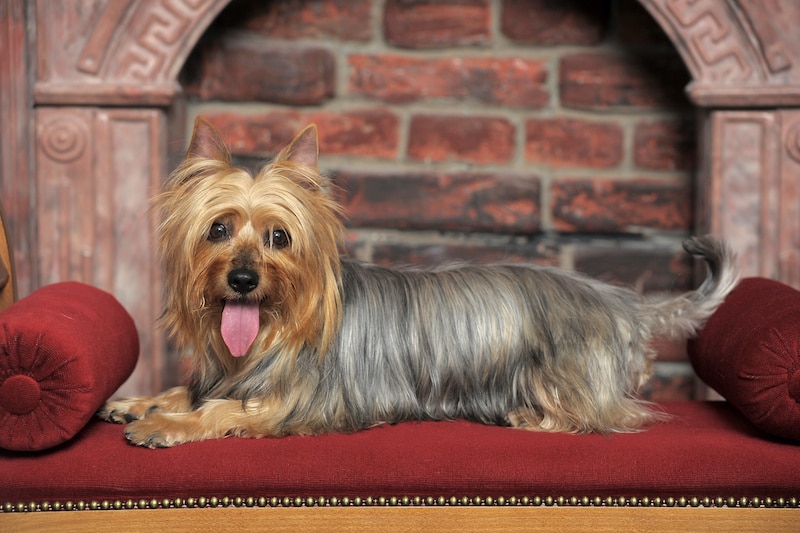Silky Terriers are small dogs that originate from Australia. They excel at hunting small, fast moving rodents and make friendly, alert and spirited companions.
Do they shed much? Silky Terriers have long, silky, single coats that molt very little throughout the year. They’re not especially difficult to groom, but given the length and texture of the Silkys coat they are prone to mats and tangles, so they do need brushing several times per week.
In this article, we’ll take a closer look at how much these little dynamos shed and how much effort it takes to maintain their coat, so you know what to expect.
Silky Terrier Shedding – What to Expect
Silky Terriers are a low shedding breed.
They’re not 100% “non-shedding,” but compared with large, heavy shedding dogs with thick double coats, they might as well be!
Overall, they molt about the same amount as a Yorkshire Terrier, which is a breed they actually share a lot in common with and are commonly mistaken for. Which is likely because, according to the American Kennel Club, they’re closely related.
Why don’t Silkys shed very much?
It really depends on the dog breed as to how much they shed, as well as the individual dog. But there are some common traits among low shedders.
For example, Silkys have a longer hair growth cycle than most dogs. Which means it takes longer for their hair to grow, fall out and be replaced compared with a higher shedding dog.
Related: What is a Hair Growth Cycle?
Another reason the molting isn’t as bad with a Silky Terrier is because they only have a single layer of hair (single coat) instead of having an outer coat and an undercoat. So they simply have less hair to shed overall, which is compounded by the fact that they’re only 10 inches tall!
Also, unlike dogs that have thick double coat, they don’t “blow their coat” once or twice a year. So for this reason Silky owners are able to dodge the big shedding events that people with big woolly dogs have to endure each year.
He’s also considered to be more “allergy friendly” than some dogs.
Not just because he sheds so little, but because his coat produces less dander than most dogs. No dog is completely hypoallergenic but he is among the breeds that are less likely to cause issues for people with pet allergies.
So, if you’re looking for a terrier breed that won’t fill your home with hair, and that is less likely to make you sneeze, he’s definitely worth considering.
Grooming Your Silky
The trade off with dogs that have longer, lower shedding coats is that they’re often more difficult to groom. And the Silky is no exception. He’s not as high maintenance as some breeds, but his coat does require more attention than the average dog.
The main reason for this is because they have long, straight, silky coats that are prone to mats and tangles. So they need to be brushed at least a few times each week to remove any painful mats they may have accumulated. As well as to keep their coat in good shape and remove any old, dead hairs.
The good news is that they’re not difficult to brush, it’s more just that you’ll need to brush regularly and each session can be a little time consuming.
How do you brush a Silky?
It’s best to start by carefully working out any mats or knots as best you can with your fingers, then gently brush with the direction of the coat using a metal comb or pin brush. And, optionally, finish up with a bristle brush to massage the skin and add shine to his coat.

The brushing process can be made a lot easier and quicker by having your Silky trimmed or clipped. Which is one of the reasons many people do this. However, the downside is that by clipping your Silkys hair, his coat won’t retain its same beautiful color or glossy texture.
Not to mention, a Silky with a shorter coat won’t trap the hair he sheds as much as one with a longer coat, so you may notice more hair dropping off of the coat in between brushes. So there are pros and cons with trimming versus letting the hair grow longer.
Either way, having him trimmed with scissors on occasion by a professional groomer, or doing it yourself if you’re comfortable, is a good idea to neaten up the hair around the face and keep the hair out of their eyes.
Silkys also need bathing every month or two with a good quality dog shampoo. And, as with most dogs, their nails need trimming because long nails can make it painful for them to walk.
Bottom Line
Silky Terriers might be small in size, but they’re mighty in spirit and are ideal for people who are interested in adopting a low shedding dog.
Their coat is higher maintenance than the average dog, especially those with short coats like the Smooth Fox Terrier or Boston Terrier for example, but it does depend on how you keep it. And either way it’s not very difficult to brush them, it’s really just a matter of implementing brushing into your routine.
The benefit of doing so is being able to enjoy the companionship of this adorable little dog without spending countless hours cleaning up loose dog hair.